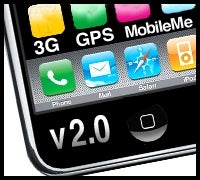 |
Friday is D-Day for the iPhone 3G. That’s when Apple and wireless provider partner AT&T plan to make the much-anticipated successor to the original iPhone available to consumers.
While Apple (NASDAQ: AAPL) didn’t make many hardware changes to the sleek device (the iPhone 3G is a bit thinner and includes a GPS chip), it’s Apple’s related decision to open up the iPhone to developers that’s the big news.
Of course, one other hardware change will help drive both software innovation and consumer adoption, and that’s the inclusion of faster 3G cellular network speeds.
“The iPhone is the first time you’ve had a true Internet browser in your pocket; the other devices people use only when they have to,” said Paul Moreton, vice president of product management at mobile software developer Quickoffice.
“The first iPhone was slower, so once you speed up that connection you’ve opened up a lot of business uses,” he added. “Where you need a Web browser to quickly find a nearby FedEx location and other ad hoc stuff, it can be really handy for business users.”
Matt Murphy, who directs the $100 Million iFund at Kleiner Perkins Caufield and Byers, notes the speed and new pricing of major importance.
“A speed increase that’s three to six times before, depending on the network availability, makes a big difference,” Murphy told InternetNews.com. The iFund was launched earlier this year by the well-known Silicon Valley venture capital firm as an investment in the iPhone ecosystem and the outside developers it’s banking will produce innovative, and profitable, applications.
Apple also is counting on new applications to drive interest in the platform. Along with the iPhone 3G, Apple is expected Friday to publicly launch its Apps Store, modeled after its wildly successful iTunes store for downloading music, podcasts, and videos.
App Store is expected to debut with over 500, mainly consumer, applications available from outside developers that will run on all models of iPhone. Apple also is enhancing the iPhone with enterprise-friendly features like support for Microsoft’s Exchange software.
One of the many developers anxious to see what happens Friday is Big Canvas, which expects to launch its first application for the iPhone when the Apps Store opens for business. Apple, which controls software distribution for the device, is checking submitted applications for viruses, inappropriate content and other criteria, so not every developer that submits an app is assured distribution. BigCanvas said it’s already been approved, though it can’t discuss details of its photo-sharing ahead of the App Store’s launch.
“Once Apple announced the SDK (software development kit) in March, I downloaded it to take a look and got excited,” said Satoshi Nakajima, founder and president of Big Canvas. “It’s so difficult to make money with mobile software, Apple’s made it much simpler. I really like the App Store concept.”
Nakajima, who was once a lead software architect at Microsoft for Windows 95 and other projects, said he’s been working on software for eight years for other mobile platforms, including the Treo, Java and Microsoft’s Windows Mobile. “But it’s almost impossible to make money unless you do business with the carriers, and that means hiring business development folks to go out and wine and dine the carriers, which is time consuming and expensive.”
Mostly free software
Most iPhone applications are expected to be free and ad supported. Nakajima said BigCanvas’s PhotoShare application will be free. He’s also mulling a “Pro” version that might be fee-based or ad-supported. But there will be some paid and subscription-based applications, particularly on the business side. Quickoffice for one doesn’t expect to launch its software till later this year, but Moreton said it will definitely charge somewhere in the sub-$100 range.
Quickoffice is already available for a range of mobile phones from Blackberry, Nokia and Palm. The software lets you view and edit Microsoft Office files on the mobile device and store those files in the cloud (unlimited storage is part of the fee it charges), where they can be retrieved on a PC or Mac or the mobile device. The files are also greatly compressed, making it more practical to speedily retrieve them on the relatively slow mobile connection.
The company uses Scalable Vector Graphics (SVG) technology that, for example, lets it shrink a five megabyte PowerPoint slide down to 20 kilobytes. “Or if you want to bring down your whole My Documents folder to the device, we let you get through it quickly,” said Moreton.
In addition to Friday’s release of Apple’s software and host of other developers, Murphy at the iFund said its received some 2,200 pitches by developers for the iPhone, though it’s not launching any iFund-powered programs till later this year.
Apple said its stores will be open starting at 8 a.m. Friday for iPhone customers. Market research firm ChangeWave just released a report this week that predicts the iPhone 3G will have “tsunami-like impact” on the smartphone market.
ChangeWave based its comments on a survey last month of 3,567 consumers. The survey found that 56 percent of those who planned to purchase a smartphone in the next 90 days (10.5 percent of the respondents) said they planned to buy an iPhone, that’s a 21 percent leap from an earlier ChangeWave survey.
ChangeWave also said one-in-two current iPhone users it surveyed are “very likely” to buy the iPhone 3G for themselves or others in the future and half of those said that purchase will be within the first 90 days of release.


